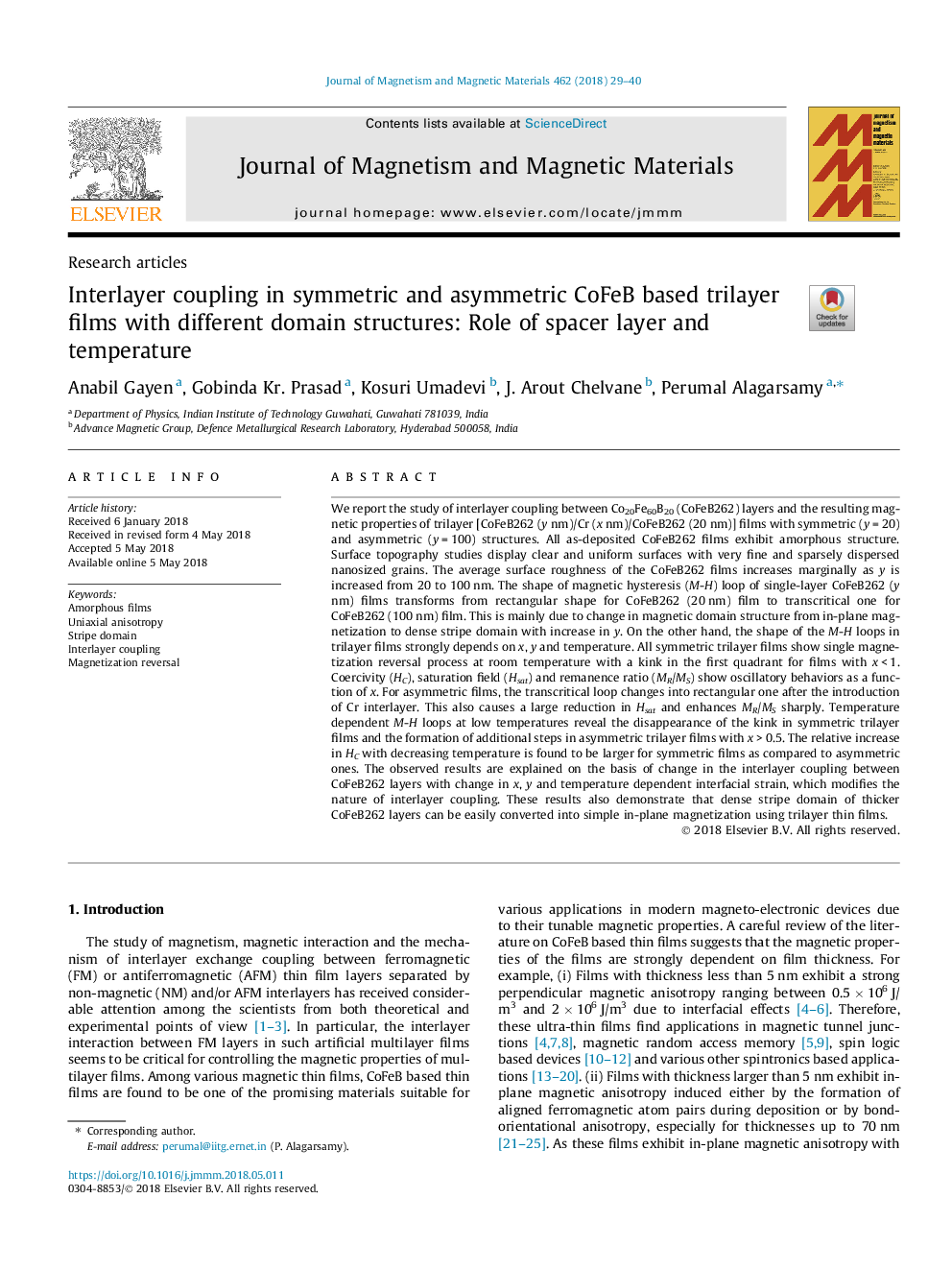| کد مقاله | کد نشریه | سال انتشار | مقاله انگلیسی | نسخه تمام متن |
|---|---|---|---|---|
| 8152741 | 1524759 | 2018 | 12 صفحه PDF | دانلود رایگان |
عنوان انگلیسی مقاله ISI
Interlayer coupling in symmetric and asymmetric CoFeB based trilayer films with different domain structures: Role of spacer layer and temperature
دانلود مقاله + سفارش ترجمه
دانلود مقاله ISI انگلیسی
رایگان برای ایرانیان
کلمات کلیدی
موضوعات مرتبط
مهندسی و علوم پایه
فیزیک و نجوم
فیزیک ماده چگال
پیش نمایش صفحه اول مقاله

چکیده انگلیسی
We report the study of interlayer coupling between Co20Fe60B20 (CoFeB262) layers and the resulting magnetic properties of trilayer [CoFeB262 (y nm)/Cr (x nm)/CoFeB262 (20â¯nm)] films with symmetric (yâ¯=â¯20) and asymmetric (yâ¯=â¯100) structures. All as-deposited CoFeB262 films exhibit amorphous structure. Surface topography studies display clear and uniform surfaces with very fine and sparsely dispersed nanosized grains. The average surface roughness of the CoFeB262 films increases marginally as y is increased from 20 to 100â¯nm. The shape of magnetic hysteresis (M-H) loop of single-layer CoFeB262 (y nm) films transforms from rectangular shape for CoFeB262 (20â¯nm) film to transcritical one for CoFeB262 (100â¯nm) film. This is mainly due to change in magnetic domain structure from in-plane magnetization to dense stripe domain with increase in y. On the other hand, the shape of the M-H loops in trilayer films strongly depends on x, y and temperature. All symmetric trilayer films show single magnetization reversal process at room temperature with a kink in the first quadrant for films with xâ¯<â¯1. Coercivity (HC), saturation field (Hsat) and remanence ratio (MR/MS) show oscillatory behaviors as a function of x. For asymmetric films, the transcritical loop changes into rectangular one after the introduction of Cr interlayer. This also causes a large reduction in Hsat and enhances MR/MS sharply. Temperature dependent M-H loops at low temperatures reveal the disappearance of the kink in symmetric trilayer films and the formation of additional steps in asymmetric trilayer films with xâ¯>â¯0.5. The relative increase in HC with decreasing temperature is found to be larger for symmetric films as compared to asymmetric ones. The observed results are explained on the basis of change in the interlayer coupling between CoFeB262 layers with change in x, y and temperature dependent interfacial strain, which modifies the nature of interlayer coupling. These results also demonstrate that dense stripe domain of thicker CoFeB262 layers can be easily converted into simple in-plane magnetization using trilayer thin films.
ناشر
Database: Elsevier - ScienceDirect (ساینس دایرکت)
Journal: Journal of Magnetism and Magnetic Materials - Volume 462, 15 September 2018, Pages 29-40
Journal: Journal of Magnetism and Magnetic Materials - Volume 462, 15 September 2018, Pages 29-40
نویسندگان
Anabil Gayen, Gobinda Kr. Prasad, Kosuri Umadevi, J. Arout Chelvane, Perumal Alagarsamy,